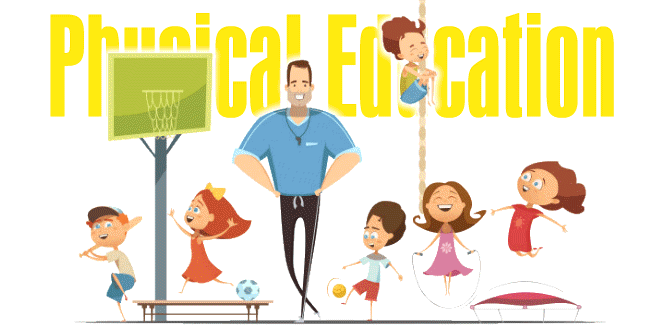Physical Activity & Leadership Training: 11th Class – Chapter 6
Physical Activity
- It is a generic term in which anybody movement that works your and require more energy than resting.
- I leads to the development of physical and mental health.
- It reduces many dangerous disease and disabilities.
- The four main types of physical activities are:
1. Aerobic (Benefits your heart and lungs most) – Walking, Running, Swimming, Bicycling, Dancing & Jumping.
2. Muscle strengthening activities (Improve the strength, power & endurance of your muscles) – Doing push-ups, Lifting weights, Climbing stairs
3. Bone strengthening activities (Helps in making your Bone strong) – Jumping rope.
4. Stretching (Improve your flexibility & ability to fully move your joints) – Touching your toes, Doing yoga stretching.
Leadership
- It is a process by which a leader guide, direct and influence the behavior and work of other towards a specific goals in a given situation.
- It is a quality that lights the path of others.
Qualities Of A Leader
- Intelligence:
(i) The leader must have the quality of firm determination & dedication for his profession.
(ii) A determined leader never leaves his task half way. - Dedication & Determination:
(i) The leader must have the quality of firm determination & dedication for his profession.
(ii) A determined leader never leaves his task half way. - Professional Knowledge:
(i) The leader must have excellent knowledge in his profession so that he is capable to make good & easy programs / plans for the attainment of goals.
(ii) The leader must be equipped with latest knowledge and research which always impresses the followers. - Good Health & Personality:
(i) The leader must have good personality trains which can influence the group effectively.
(ii) The leader must have physical fitness so that he should not feel any type of fatigue for completing the daily task. - Friendliness & Co – operative Behavior:
(i) A leader should be co-operative with his followers and make friendly environment which will be very helpful for achieving the desired goals. - Honest:
(i) Honest leader will always utilize the material and funds for the better learning of the group which is welcomed by the group and it leads to the attainment of goals very smoothly and honestly. - Disciplined:
(i)The leader who is disciplined can lead group in discipline manner.
(ii) Regularity and punctuality is the best example for discipline behavior. - Emotionally Balanced:
(i) The leader should maintain his emotions which give power to the unity of group like fear, anger, jealously & anxiety should be balanced.
(ii) The emotional disturbances often consume too much of mental energy which can be used for constructive work.
Role Of Leader:
- Organizer – Leader acts as an organizer and distributes the work among the followers which saves energy & time which helps the group to work in a systematic manner.
- Psychologist – A good leader knows the mental skills and toughness of the players.
- Guardian – Experienced leaders remove the misconceptions & confusions of the members of the group.
- Teacher – Leader helps in producing ideas, techniques, views and opinion of the group.
- Motivators – A good leader always motivate his group in every situations of life.
Process Of Becoming Leaders Through Physical Education:
The main aim of physical education is overall development of a student. Through the participation in physical education programmes, the qualities of a student can be developed to a greater extent and the beginning of these chances / opportunities starts from the classrooms, play-field, camps or tourist places where their latent ability can be exposed to a greater extent for example:
- Making a student class monitor.
- Making a student leader of physical activities.
- Making a student team captain.
- Making a student responsible for preparing play field.
For making effective leaders, the following points must be considered:
- Leadership Style: The leadership style is effective and productive because effective leader always evaluate the situations & decide quickly.
- Team Building: Effective leader always develop the unity of team which is required in every competitions for achieving the goals.
- Decision Making: A good leader makes decision to find strategies to win and influence others to solve problems efficiently in minimum possible time. Effective leader must have quality to make wise decisions.
- Communication: A leader must have good communication skills that can effectively communicate with others.
Some opportunities available to act as a leader in sports:
- Manager of the team
- Coach of the team
- Officials of the match
- Leader for warming up
- Demonstrator of mass drills
Adventure Sports: Physical Activity & Leadership Training
- It is comprised of unlimited excitement, entertainment and risk in participant competes in natural environment with different adventurous activities.
- It is categorized in four parts:
1. Adventure sports on Mountains
2. Adventure sports in Air
3. Water sports
4. Winter sports
Objectives Of Adventure Sports
- To improve Positive Attitude
- To build Self Confidence
- To Develop Concentration and Attention
- To Improve Curiosity
- To Channelize Surplus Energy
- To Develop Leadership Qualities
- To Develop Physical Fitness
- To Develop Social Relations
- To Provide Recreation
- Information & Knowledge Enhancement
- Stress Buster
- Thrill, excitement and fun
- Self Assessment
Adventurous Activities
Rock Climbing
- It is one of the dangerous activity in which participants climb up and more across the rocks like walls with full of alertness, flexibility, power, co-ordination etc.
Material Requires:
- First aid kit
- Clothing
- Helmet
- Water bottle
- Torch light
- Harness
- Climbing shoes
- Ropes
- Carabiners
- Sun glasses
Safety Measures:
- Before climbing up, make sure you have tied properly your harness, buckles of jeans and knots of chord.
- Helmet protects head from falling on rocks and falling of rocks also.
- Use proper ropes for climbing.
- Always wear climbing shoes because gripping can prevent us from falling.
Types Of Rock Climbing:
- Traditional Rock Climbing: In this climbers have to place wedges, nuts and other forms of protection from their racks into cracks in the rocks.
- Sports Rock Climbing: In this the protective pieces are permanently bolted into the rock.
- Indoor climbing: In this the structures made of plywood or concrete and artificial handholds are fixed on the wall.
Techniques:
- Step 1 – Warming up and stretching exercises are done before the star of climbing.
- Step 2 – Tie harness on the body to protect for sudden fall.
- Step 3 – The legs are used to lift body and the hands used only to guide the direction.
- Step 4 – Don’t go away from the wall and don’t look very up & down. Only stay focused on general area.
- Step 5 – Don’t climb fast, take your time and hold tightly.
- Step 6 – Climb couple of feet and then take rest for a while to recover then again start the climbing.
- Step 7 – While coming down, the speed should also be slow to prevent falling.
Trekking
- It is also known as combination of hiking and walking activity. This activity is done for many days and generally panned away from urban areas.
Material Required:
- First aid kit
- Clothing
- Sleeping bag
- Water bottle
- Torch light
- Trekking stick
- Miscellaneous items (Small knife, Sunglasses, Soap, Food items Tents)
Safety Measures:
- Always try to do trekking with team because being alone it can be danger.
- Never trek in bad weather conditions.
- Always wear a full sleeve shirt & trousers to protect from insect bites.
- The person who have heart and lung related problems should not go for trekking.
Types Of Trekking:
- Tea House Trekking: It is known as doing trekking by eating and sleeping at tea house.
- Camping Trekking: In this type of trekking the trekkers carry all food items and tents and all sleep in tents.
Grading:
- Easy Trek: It is meant for beginners and the duration of trekking can last up to 7 days
- Moderate Trek: The trekkers face more challenging routes and they are longer & can last up to 10 days.
- Strenuous Trek: The route is elected to high altitudes uo to 5000 m and they can last up to 15 days .
- Difficult Trek: The route has some steep ascents to high altitudes and it will take 20 to 40 days to cover up.
Techniques:
- Maintain Pace
- Rhythmic Trekking
- Use of Trekking Sticks
River Rafting
- It is a challenging recreational outdoor activity which is done with inflatable raft and small groups of people float down a river on a raft. The raft are made of nylon fabric and coated by neoprene.
Material Required:
- First aid kit
- Clothing
- Helmet
- Raft
- Personal Flotation Device
- Oars and Paddles
- Life Saving Jacket
Safety Measures:
- Always try to do rafting with team because being alone it can be danger.
- Always learn well all the skills of protecting yourself.
- Always wear helmet and life saving jacket.
- Never do rafting in darkness.
- Rafter should have knowledge of the river and route.
Types Of River Rafting:
- Oar Raft
- Paddle Raft
- Oar Assisted Paddle Raft
- Catarafts
- Inflatable Kayak
- Rig
Techniques:
- Technique for Oars: When in rafting, it is not just about arm movement but entire upper and legs all play a major role in providing the raft sufficient power to run.
- Technique for Paddles: To maintain balance, paddlers should on both sides. The paddlers inside hand provides grip to top of paddle and outside hand hold the stem of paddle.
Mountaineering:
- It is a challenging activity that leads to climbing up to mountains to its peak and makes a long journey that includes walk on rocks and snow.
Material Required:
- First aid kit
- Climbing Ropes
- Climbing harness
- Sleeping Bags
- Crampons
- Ice Axes
- Clothing (Wind / Water proof)
- Sun glasses
Safety Measures:
- Always wear the insulted clothing to protect the body from severe cold climate.
- Always use sun glasses and sun screen creams to protect from skin burn which is very common on high altitudes.
- Always carry the route map and enable the GPS navigation system for saving from any incident.
- Always wear climbing shoes attached with crampons for advance gripping.
Techniques:
- Mountaineers use climbing ropes attached to them with harness.
- On the ice slopes the climbers use ice axes and set of metal spikes which is also known as crampons.
- In case of difficult terrain belaying technique is used in which leader ascends and the second mountaineer release the rope from a secured position. While advancing, the leader fixes gear into snow. The lead climber belays the second climber who also removes gears for its further use.
Surfing:
- It is the sport of riding waves in a standing or horizontal position on a surf board.
- It is performed in ocean, river, man-made created waves and glide across the surface of the water.
- The surface ride stands on surf boards and steer the water nearly parallel to the beach toward the shore.
- The surf board is made from solid wood of 10 to 16 feet long.
Material Required:
- First aid kit
- Clothing (Wet Suit)
- Surfboard
- Fins
- Leash
Safety Measures:
- Always surf at places patrolled by surf lifeguards.
- Surf between the red and yellow flags.
- Always surf under supervision or with a friend
- Read and obey the signs.
- Don’t surf directly after a meal.
Types Of Surfing:
- Short Board
- Fish Surfboard
- Fun Board
- Long Board
- Hybrid
Technique:
- First pick the right wave.
- Take off is done after watching where the wave is breaking more.
- Always keep center of gravity at lower level.
- Paddle with closed fingers.
- Adjust feet while riding the wave.
Para Gliding: Physical Activity & Leadership Training
- It is jumping off from mountains with a parachute of being pulled into the air behind a boat with a parasail.
- Pilot fly off mountains and the movement of air into the canopy inflates it and gives it aerodynamic shape.
Material Required:
- First aid kit
- Variometer
- Helmet
- Harness
- Radio
- GPS
- Sun glasses
- Protective gear (Knee, elbow, chest and should pads)
Safety Measured:
- First learn to fly from a fully qualified paragliding instructor.
- Plan your fly beforehand.
- Always check the weather conditions, don’t fly in the sky when the weather in its terrible warth.
- The gliding wings should be made of good fabric.
Types Of Para Gliding:
- Non powered paragliding: It is done with assistance of natural wind only. The pilot runs few steps and the para glider gets inflated and then flies of the mountain.
- Powered paragliding: In this the pilot wears the motor on his back which provides enough thrust to take off.
Technique:
- The para glider is laid out on the ground at the top of the mountain on a gentle slope and facing into the wind.
- The pilot should be connected to the paraglider with a special harness.
- The paraglider is then pulled gently into the wind, which causes the paraglider to inflate.
- The pilot then takes a few steps into the wind floats gently up into the air.
Physical Activity & Leadership Training: Questions Carrying 03 Marks
- Define leadership by giving two quotations.
- Write any three qualities of a good leader.
- Elaborate the role of a leader.
- Describe the opportunities available to act as leader in sports.
- What are adventure sports?
- Elaborate objectives of adventure sports.
- What are the material requirements for trekking?
- Explain the types of surfing.
Physical Activity & Leadership Training: Questions Carrying 05 Marks
- Explain the concept of physical activity.
- Describe the concept of physical inactivity.
- Define leadership. Explain the qualities of a leader.
- Elaborate the Behavior change stages for physical activity.
- Define adventure sports. Discuss its objectives.
- Describe rock climbing and explain about its safety measures.
 Class Notes NCERT Solutions for CBSE Students
Class Notes NCERT Solutions for CBSE Students



